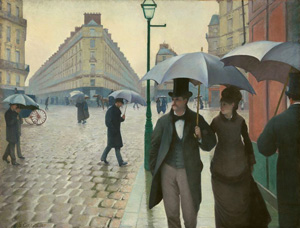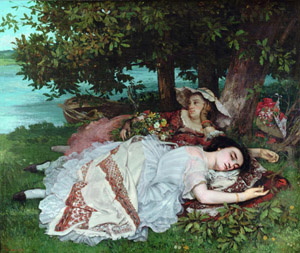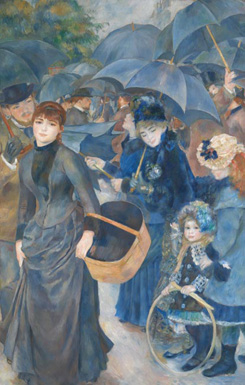A la Mode
John Haberin New York City
Impressionism, Fashion, and Modernity
"The latest fashion . . . is absolutely necessary for a painting. It's what matters most." But was la mode truly the standard for modernity?
Did Edouard Manet, speaking in 1881, even mean fashion in the sense of the style section of The Times, rather than the style of painting? Almost surely not—not when painting was changing as never before. The Met must know it, too, but it also knows that the play on words is hard to forget. As wall text, it opens "Impressionism, Fashion, and Modernity," and it has opened more reviews than just mine. A placement of period dress amid some eighty well-chosen paintings has to get people talking about Paris and the birth of modernity. Now if only it also got people talking about what its high gloss and high style leave out. 
Ready-to-wear
A little over halfway through, like all blockbusters, this one has an alcove for reading. Not everyone will settle in with the catalog, but it is hard to miss the letters above, in the typeface of an actual newspaper ad: Les Grands Magasins du Louvre. Not all that many either will think of a department store when they hear of the Louvre. Yet this store opened in the 1850s, almost twenty years before the first Impressionist exhibition, as did Le Bon Marché. They introduced ready-to-wear clothing to a public that had not had access to much in the way of fashion. Could that have also been the public for new painting?
These days, long after Félix Vallotton painted the store of that name, bon marché means cheap in French, but "Impressionism, Fashion, and Modernity" looks anything but cheap. It also has a point. Maybe we'll always have Paris, but we did not always have Paris as it is today. Its boulevards are a product of Baron Georges-Eugène Haussmann's sweeping exercise in urban planning, much of it in the 1860s, just when this show is getting underway. The show ends in a room with a fish-eye panorama of converging avenues and diverging passers-by in the rain, by Gustave Caillebotte, but anticipating Rackstraw Downes today. Such orienting and disorienting public plazas were only part, though, of the city's modernization, along with the Bibliothèque Nationale by Henri Labrouste—and the department stores came first.
Painters took notice, too. One thinks of Impressionism as the direct observation of light and color, in the countryside in bloom. Jules Antoine Castagnary saw the change coming in 1863, the year that artists broke with the juried Salon exhibition to hold the Salon des Refusés. A new "naturalism," Castagnary declared, "reestablishes the broken relationship between man and nature." Maybe so, but the young Paul Cézanne in 1881 borrowed a seemingly natural composition from an advertisement. A young woman in Paris, as painted by Pierre-Auguste Renoir, is reading a fashion magazine—and Renoir was himself the son of a tailor.
The show starts with a room for full-dress poses, including a portrait Claude Monet. A critic once accused these artists (Edouard Manet in particular) of "valuing a head no more than a slipper"—or, one might add for Manet, a striped dress And Monet's very title, Camille (The Green Dress), suggests why. It is quite a dress, too, trailing behind his wife in wide green and black stripes beneath a top bordered in fur. Earlier, Gustave Courbet painted Young Ladies on the Banks of the Seine as women of easy virtue—and "wretchedly dressed" at that. This show, however, will be about a different kind of realism, a different fashion, a different class of men and women, and a different ideal of leisure.
The second room takes up a defining moment in Impressionism—plein-air painting, or painting executed outdoors. And then it tries to redefine that moment. It includes the two surviving fragments of Monet's Luncheon on the Grass. The artist meant something so large and ambitious that he ended up painting in his studio, where he could pose men and women in shimmering black and white. He also buries the faces of Women in the Garden in profile, shadow, or flowers. If one remembers only their dresses, their strange repose beside a path half covered in shadow, or the strange motion of one woman into the trees, so be it.
 Already, black and white take on a life of their own. Each in fact gets a room, the black a trademark of Manet and the white of his sister-in-law and closest follower, Berthe Morisot. Manet paints her on equal footing with her fan, the sofa, and a painting of tumultuous gods and goddesses. She in turn paints two sisters like spooky alternate views of a single sitter, modeling a floral white dress. Could Morisot's feathery touch derive from a love of fabric? What often seems evasive in her technique may make sense after all.
Already, black and white take on a life of their own. Each in fact gets a room, the black a trademark of Manet and the white of his sister-in-law and closest follower, Berthe Morisot. Manet paints her on equal footing with her fan, the sofa, and a painting of tumultuous gods and goddesses. She in turn paints two sisters like spooky alternate views of a single sitter, modeling a floral white dress. Could Morisot's feathery touch derive from a love of fabric? What often seems evasive in her technique may make sense after all.
Another room brings in the millinery business, as with Edgar Degas, along with the advertising. Men dress up, too, even before John Singer Sargent and Sargent's portraits, at the club and the stock exchange. Settings broaden to society and its spectacles, as with the Renoir of Renoir drawings and Mary Cassatt at the theater. They paint not the stage but the loge, in an art about watching and being watched. Last comes Haussmann's Paris and the final Impressionist exhibition, of 1886. Georges Seurat exhibited his Grande Jatte there, seen here only in a study, and one has to notice how a woman's mass and stillness derive from a bustle.
A community of shoppers
The Met tells a terrific story—the story of Manet's woman before a mirror or Renoir's woman on a swing. On that rainy day in Paris, umbrellas were commodities, too. I went expecting the origins of Impressionism as a lame excuse for a costume exhibition. At most a couple of mannequins hold the floor in each room, between walls with paintings as fine as those. Susan Alyson Stein worked with Gloria Groom of the Art Institute of Chicago, Guy Cogeval and Philippe Thiébaut of the d'Orsay in Paris, and others from the Met's departments of painting and design. They did not often have to settle for less.
The story they tell of Impressionism is comforting and familiar—as the ultimate bourgeois idyll. It tells of the discovery of leisure and the invention of the weekend. It includes excursions from the city, theaters and cafés, and of course shopping. In a play, a dance, or a piano lesson, a painting on the wall or a picnic on the grass, it pictures art as a confluence of the senses. Renoir's woman on a swing comes with a husband, a child, and a small dog. Blues saturate her white dress as it dissolves in sunlight.
It is the story of the artists themselves, as a community of friends. They pose for one another, like Morisot for Manet, her face clear-eyed and sober. Frédéric Bazille lends Renoir a commanding ease and intelligence, his legs drawn up in a chair. Bazille in turn poses for Luncheon on the Grass not just once, but twice, as two separate figures. And his most famous painting is a family reunion, its backs to an infinite landscape. One can look at the stern or bored faces, united by little more than a stone parapet and the trees of southern France, and imagine him happy to return to Paris.
It is a social history that goes back to the artists as well and their supporters. Castagnary wrote of naturalism as "putting man back into society from which the psychologists have withdrawn him." Art now "accepts all the realities of the visible world and, at the same time, all ways of understanding these realities." Emile Zola, for whom a true artist "loves his own time," covered much the same ground in his novels. Charles Baudelaire titled his manifesto, also published in 1863, "The Painting of Modern Life." One can almost overlook how much he preferred Eugène Delacroix and Romanticism.
It is also the story of changing critical views of Impressionism. Once the movement stood for color alone and truth to nature, as a giant step on the way to modern art. Only recently has its social history come so much again to the fore, propelled by Marxism, Postmodernism, and feminism. John Rewald wrote his magisterial The History of Impressionism for the Museum of Modern Art in 1946. Its fourth still does not so much as list Haussmann in its index. T. J. Clark, in his own groundbreaking The Painting of Modern Life of 1984, takes Haussmann's Paris as a theme—and cites department stores.
Change has also come with attempts to place design on equal footing with painting, as with Huguette Caland. These attempts may go back to Modernism, the Bauhaus, and Bauhaus photography, but they also involve working backward from a view of contemporary art that includes textiles and women. The Frick has already exhibited "Whistler, Women, and Fashion." The Met just adds the fashion. The designers of a day dress remain anonymous, unlike the painters. Yet that, too, is part of a social history of the ready-to-wear as the ready-made.
Fashion's hall of mirrors
It is a comforting story, for sure, but is it true? Right off, one should distrust any story that reduces art to its subject matter, but most especially Impressionism. Castagnary discarded the label realism with good reason. At last, artists were in search of modern life and of art as an end in itself—and it had become impossible to disentangle the two. If they valued faces no more than slippers, perhaps they had demoted faces rather than elevating fashion. It really does matter that Renoir drowned that white dress in sunlight and blue. 
Even if one focuses on the subject, just how privileged was fashion anyway? Monet painted his wife and her green dress amid excursions to Parisian gardens and coastal Normandy. He meant Luncheon on the Grass to bring natural light to Manet's Déjeuner sur l'Herbe, working from sketches on the spot. He also could hardly have missed how Manet had shocked his audience by seating a nude woman with well-dressed men. Apparently, not everyone cared for the variety of women's dresses. And not everyone saw fashion as less than a scandal.
At the Met, that side of a social history goes unseen. It has shopgirls and milliners, but for their display of consumer choices rather than their labor. It quotes Zola, but not his novels with their harsh view of factories and department stores. It omits Morisot's painting of a laundry outside Paris—in effect, a sweatshop. It also omits the scandal of the artists themselves, from Morisot's lazy slouch on a sofa for Manet to the psychological tension and disunion in Bazille's family. In this show, when the going gets tough, the tough get shopping.
Were artists, then, at ease with the latest thing or actually ahead of the game? As T. J. Clark asked, "Are we to take Impressionism's repertoire of subjects and devices as merely complicit in the spectacle—lending it consistency or even charm—or somehow disclosing it as tragedy or farce?" Maybe both at once, and that speaks to their relevancy. Bazille was from a wealthy family, while Camille Pissarro was a socialist and a Jew. Mostly, though, they were neither entirely within nor entirely apart from the rising middle and upper-middle class, much like artists as the seeds of gentrification today. And their works, Zola hastened to add, are "neither banal nor unintelligent fashion pictures."
Between tragedy and charm, "Impressionism, Fashion, and Modernity" comes down on just one side of the equation. It may not take falling back on lesser work from private collections, but it does take some doing. It takes lesser, more conservative artists like Carolus-Duran, Albert Bartholomé, Jean Béraud, Jacques-Emile Blanche, Charles-François Marchal, Henri Fantin-Latour, or Alfred Stevens. It takes a ton of Morisot and James Tissot, with his dark colors, cramped spaces, flattering poses, crisp outlines, and slick surfaces for buyers from the British upper class. It allows Manet's woman at a mirror or Caillebotte's heavyset, slightly rumpled young man in a bar, his back to a mirror. It sets aside how much of Impressionism's pleasures existed only in a hall of mirrors.
It does so because of still another change over the last decades—toward art's blockbusters and growing audiences. The Met knows that "Impressionism" and "fashion" will each sell themselves, much less in combination. It knows that when Eva Gonzalès paints shoes, visitors will think first of Sex and the City. It knows that the ready-to-wear dresses of a past century will look lavish today. To quote Clark again, he hoped that his readers could look at Impressionists and be "struck again by their strangeness." This show has some of the best paintings in New York, this year or any year, but almost none of their strangeness.

"Impressionism, Fashion, and Modernity" ran at The Metropolitan Museum of Art through May 27, 2013. Renoir's rainy day does not appear at the Met, but it makes too good a contrast to Caillebotte's to pass up. In fact, Clark was pairing them in his conundrum quoted here.




